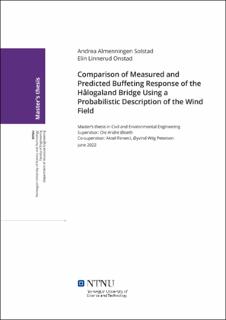| dc.contributor.advisor | Øiseth, Ole Andre | |
| dc.contributor.advisor | Fenerci, Aksel | |
| dc.contributor.advisor | Petersen, Øyvind Wiig | |
| dc.contributor.author | Solstad, Andrea Almenningen | |
| dc.contributor.author | Onstad, Elin Linnerud | |
| dc.date.accessioned | 2022-09-21T17:19:19Z | |
| dc.date.available | 2022-09-21T17:19:19Z | |
| dc.date.issued | 2022 | |
| dc.identifier | no.ntnu:inspera:107175085:22430511 | |
| dc.identifier.uri | https://hdl.handle.net/11250/3020476 | |
| dc.description.abstract | Hengebruer med lange spenn er svært utsatt for vindindusert respons, på grunn av slankheten til disse konstruksjonene. Derfor er det viktig å kunne predikere responsen forårsaket av vind. Variabiliteten til vinden gjør det imidlertid vanskelig å gjøre nettopp dette. Formålet med denne oppgaven var derfor å vurdere hvor godt buffeting-teorien og vindfeltmodeller var i stand til å predikere den vindinduserte responsen til Hålogalandsbrua.
For å ta variabiliteten til vinden med i betraktning, ble data fra målesystemet på Hålogalandsbrua prosessert og analysert. En covariance-driven stochastic subspace identification ble utført. Dette ble gjort for å evaluere nøyaktigheten til den numeriske modellen av brua, som ble brukt i responsberegningene. Informasjon om den aerodynamiske oppførselen til brua, som var nødvendig for å modellere vindlasten, ble funnet ved hjelp av vindtunneltester. Buffeting-responsen til brua ble deretter predikert. For å bestemme turbulensparameterne som krevdes for å modellere vindlasten, ble to ulike sannsynlighetsbaserte metoder brukt. I den første metoden ble parameterne bestemt ved å bruke spesifikke persentiler fra sannsynlighetsfordelingene deres. I den andre metoden ble en probabilistisk modell brukt til å simulere turbulensstandardavvikene. Til slutt ble den predikerte og den målte responsen sammenlignet.
Den numeriske modellen viste seg å være nøyaktig nok til å kunne brukes i responsprediksjonene. Videre viste analysen av vindfeltet at det var stor variasjon i vindens egenskaper. I den probabilistiske modellen ble turbulensstandardavvikene modellert som korrelerte og lognormalfordelte stokastiske variabler, avhengige av den gjennomsnittlige vindhastigheten og -retningen. Modellen klarte å representere de virkelige turbulensstandardavvikene, tydeliggjort av den gode overensstemmelsen mellom de simulerte og de målte parameterne.
Det ble observert at variabiliteten til vinden forplantet seg inn i den målte responsen. Den laterale og vertikale responsen ble godt predikert, mens torsjonsresponsen ble overestimert. Imidlertid var den gode overensstemmelsen for den laterale responsen uventet. Videre klarte den probabilistiske modellen av turbulensstandardavvikene å overføre variabiliteten til vinden inn i den predikerte responsen. Det viste seg at turbulensparameterne påvirket prediksjonene i stor grad. I tillegg hadde variabler, som modale parametere og aerodynamiske deriverte, stor påvirkning.
Ved å bruke en sannsynlighetsbasert metode klarte buffeting-teorien og vindfeltmodellene stort sett å predikere responsen til Hålogalandsbrua. Imidlertid viste det seg å være svært viktig å estimere nøyaktige verdier av alle variabler for å oppnå gode responsprediksjoner. | |
| dc.description.abstract | Long-span suspension bridges are prone to wind-induced response due to the slenderness of these structures. Therefore, it is important to be able to predict the response due to wind. However, this is made difficult due to the variability of the wind. The aim of this thesis was therefore to assess how well the buffeting theory and wind field models were able to predict the wind-induced response of the Hålogaland Bridge.
In order to take the variability of the wind into account, measurement data from the monitoring system on the Hålogaland Bridge were processed and analysed. A covariance-driven stochastic subspace identification was performed. This was done in order to assess the accuracy of the numerical model of the bridge used in the response calculations. Information about the aerodynamic behaviour of the bridge, required to model the wind load, was obtained through wind tunnel tests. The buffeting response of the bridge was then predicted, using two different probabilistic approaches to obtain the turbulence parameters needed to model the wind load. First, the parameters were determined as specific percentiles from their probability distributions. Next, a probabilistic model was used to simulate the turbulence standard deviations. Finally, the predicted and measured response were compared.
The numerical model was found to be satisfactory for use in the response predictions. Furthermore, the analysis of the wind field revealed a large variability of the wind characteristics. In the probabilistic model, the turbulence standard deviations were modelled as correlated and lognormally distributed random variables, dependent on the mean wind speed and direction. The model managed to represent the true turbulence standard deviations, evident by the good agreement between the simulated and the measured parameters.
It was observed that the variability of the wind propagated into the measured response. The lateral and vertical response components were well predicted, while the torsional response was overestimated. However, the good agreement for the lateral response was unexpected. Furthermore, the probabilistic model of the turbulence standard deviations was able to translate the variability of the wind into the predicted response. It was found that the turbulence parameters greatly affected the predictions. Additionally, variables such as modal parameters and aerodynamic derivatives had a great impact.
Using a probabilistic approach, the buffeting theory and wind field models were mostly able to predict the response of the Hålogaland Bridge. However, determining accurate values of all variables was found to be of utmost importance in order to obtain satisfactory predictions. | |
| dc.language | eng | |
| dc.publisher | NTNU | |
| dc.title | Comparison of Measured and Predicted Buffeting Response of the Hålogaland Bridge Using a Probabilistic Description of the Wind Field | |
| dc.type | Master thesis | |
